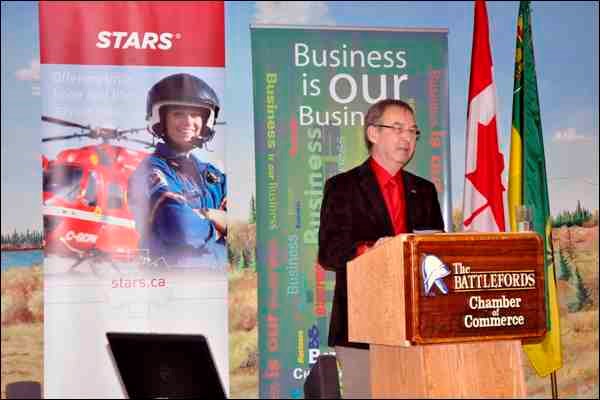The past week proved to be a big one for Saskatchewan's STARS Air Ambulance service.
STARS, the acronym for Shock Trauma Air Rescue Society, began 12-hour-a-day service out of Saskatoon last fall. It was announced Feb. 25 that the service had expanded to 24 hours a day Saskatchewan from a base at John G. Diefenbaker Airport in Saskatoon.
That is in addition to the current 24-hour-a-day service out of Regina, where they have operated since last spring. Three provinces now have the STARS service, including Manitoba and their original base of operations Alberta, where STARS began in 1985.
Since entering Saskatchewan last year, STARS air ambulance helicopters have been in use across the province, transporting those critically-ill and injured patients to waiting hospitals.
The latest expansion served as a backdrop to a presentation about STARS Friday at the Battlefords Chamber of Commerce.
The guest speaker was former Saskatchewan finance minister Rod Gantefoer, now executive vice-president of the Saskatchewan STARS foundation.
The announcement that STARS was going 24-hours a day out of its Saskatoon base was good news, Gantefoer told the News-Optimist.
"Now we're 24 hours out of Regina and Saskatoon. Both bases are full capacity, if you like, and we're happy to provide that service."
There are two crews - a day crew and a night crew - ready to go for that period, with two pilots on duty, two medical people - a nurse and a paramedic - and also a transport physician on call 24 hours a day.
Gantefoer outlined the message that he wanted to send to those in attendance at the luncheon about what the STARS Air Ambulance service offers.
"We're new to the province, we have a role to play in the chain of survival. We have tremendous partners in first-responders, ground ambulance, fixed wing and the medical system so we bring a new dimension of safety and protection to people that are critically ill or injured."
He was also there to encourage people to get involved and help raise money for STARS, who receive corporate donations and also run a home lottery to help raise funds.
The motto of STARS is "when seconds count," and Gantefoer noted "literally that's the difference between life and death for many people in the province."
He talked about the STARS air ambulances themselves and what they do. The BK117 helicopters are designed as miniature ICU units, capable of responding to an emergency or an accident scene within minutes.
"It really is an emergency room on wings," said Gantefoer.
The target is to be airborne within eight minutes, he said.
Gantefoer said future plans include adding new AW139 helicopters to the fleet.
That model's enhanced features include retractable landing gear with tires, a considerably faster speed and better adaptability to flying icy conditions compared to the BK117. The AW139 is also designed to look after two patients on full life-support, while the current helicopter is equipped to support one.
Gantefoer said they expect it to arrive in Saskatchewan this fall and be in operation next year.
Gantefoer also spoke about the need for helipads in the province to accommodate the STARS service.
Right now they are located on Saskatoon's east side near Wilson's Greenhouse, but Gantefoer said there are plans for a temporary helipad is to be built near Royal University Hospital north of the parkade.
Gantefoer believes this will shave 10 minutes off their missions from what it is now. Ultimately the permanent location will be on the roof of the new children's hospital.
As for helipads elsewhere, Gantefoer noted North Battleford "needs a helipad today, or yesterday, really." Currently STARS lands at the airport, with ground ambulances transporting patients to and from the hospital.
"It can all save time if we can land right at the hospital," said Gantefoer. He notes the Ministry of Health would cover 80 per cent of the cost, with the local health region covering 20 per cent.
"If we are in a position to save five or 10 minutes it's a big deal," said Gantefoer.
According to numbers provided by STARS, there were 217 Saskatchewan missions in 2012. Five of those involved North Battleford, making the city a busy early user of the STARS service.
"North Battleford is the busiest place we've gone to from Saskatoon," said Gantefoer.
Counting the 2013 numbers, Gantefoer estimates there have now been 275 missions in Saskatchewan using STARS since it started.
"That's 275 people who have gotten care quicker, faster than they would have otherwise. In some of those people it may have made the difference in them being alive or not. We think that's that important."
Gantefoer also notes the importance of the service to those in more remote and less-populated areas. He called it "a comfort to people across rural Saskatchewan that we're there to help them."
In terms of how the program operates, about 50 per cent of the calls are hospital-to-hospital transfers where a patient is transported from one hospital to another for the appropriate treatment for critical-care situations. Those include stroke and heart attacks, and also traffic accidents where the patient arrived at one hospital first and needed transferred to another for further treatment.
A good portion of the other missions, making up about 40 per cent, are emergency response to accidents, with STARS ambulances capable of landing right at the scene. The helicopters are able to land on highways and even in farmers' fields.
Appreciation for the STARS air ambulance service was expressed by a couple of interested audience members who had some direct experience with the service last fall.
Gregg Sheppard stood up and said that his brother-in-law, who was with him at the luncheon, was the first patient to fly out of North Battleford with STARS after suffering a cardiac arrest.
Soon after they got the call, "Rae was back at the University Hospital in Saskatoon," said Sheppard. "I just wanted to express my appreciation first hand and say thank you for a job well done."




